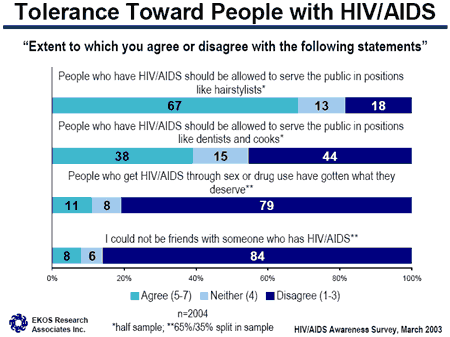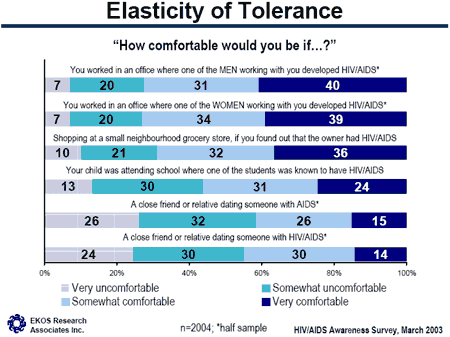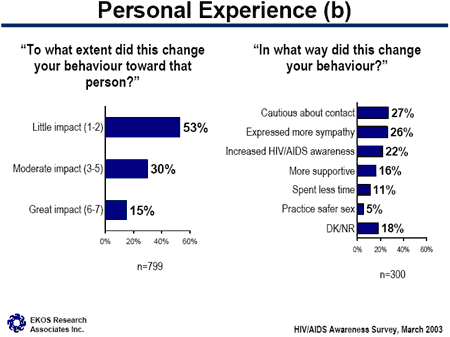Common menu bar links
Institutional links
Diseases & Conditions
Health & Safety
Research & Statistics
Agency Information
Search Box
HIV/AIDS - An Attitudinal Survey
Final Report
Previous | Table of Contents | Next
5. Tolerance Towards People with HIV/AIDS
5.1 Tolerance
The level of tolerance of Canadians towards people with HIV/AIDS was examined through a number of statements. While most Canadians do not blame people with HIV/AIDS for their condition and most feel they could be friends with someone living with HIV/AIDS, they are less certain as to whether they feel comfortable having them serve the public.
Less than one in ten (eight per cent) agree that they could not be friends with someone who has HIV/AIDS while the vast majority (84 per cent) believe they could be friends with someone with HIV/AIDS. Furthermore, over three-quarters do not believe that people infected with HIV/AIDS through sex or drug use have gotten what they deserve, although one in ten (11 per cent) do agree with this statement. A significant portion of the population, however, does not believe that people with HIV/AIDS should be allowed to serve the public in certain occupations. While two-thirds (67 per cent) agree that people with HIV/AIDS should be allowed to serve the public in positions like hairstylists, fewer than four in ten (38 per cent) believe that people with HIV/AIDS should be allowed to serve the public in positions like dentists and cooks. In fact, almost half of Canadians (44 per cent) believe that they should not be allowed to serve the public in these capacities.
The levels of tolerance towards people with HIV/AIDS is significantly different among people in the United States. In 1997, nearly three in ten Americans (28 per cent) believed that "people who got AIDS through sex or drug use have gotten what they deserve". In 1999, one fourth of Americans held this view.1
Similarly, the level of tolerance afforded those afflicted with HIV is seen in other circumstances as well. Previous research has shown that a majority of Canadians (85 per cent) believed the best solution for treating injection drug users was enrolment in rehabilitation programs rather than more drastic measures such as alienating them from society completely.2

- Older Canadians demonstrate significantly lower levels of tolerance. Seniors are significantly less likely to say that they could be friends with someone with HIV/AIDS (only 61 per cent could). They are also more likely to believe that people who have contracted HIV/AIDS through sex or drug use have gotten what they deserve (20 per cent), and to believe that people with HIV/AIDS should not be allowed to serve the public in positions like dentists, cooks (66 per cent) or (to a lesser extent) hairstylists (30 per cent).
- Those with lower education and income are less likely to say that they could be friends with someone with HIV/AIDS (77 per cent could), as are those with a low level of perceived or actual knowledge (75 per cent could). Those who know someone with HIV/AIDS are more likely to say they can (89 per cent). Canadians with lower income levels are more likely to believe that people who have contracted HIV/AIDS through sex or drug use have gotten what they deserve (16 per cent of those with incomes below $40,000).
- Those born outside Canada are also more likely to blame people who have contracted HIV/AIDS through sex or drug use for their condition (19 per cent do), as do people who believe the risk of HIV has grown in the last five years (15 per cent do). Those born outside Canada and Canadians who are likely to distance themselves from HIV/AIDS are less likely to.
- Those with university education and individuals with a high level of knowledge are more likely to be accepting of people with HIV/AIDS in positions like cooks, dentists (45 and 43 per cent, respectively) or hairstylists (74 and 73 per cent, respectively).
| In summary, senior citizens, those with lower education and income and knowledge tend to be less comfortable with HIV/AIDS in their own circle of contacts or serving the public and tend to place blame on victims more readily than other Canadians do. This is also true of people born outside Canada. On the other hand, upper education and income Canadians, those with higher knowledge levels and/or who know someone with HIV/AIDS tend to be the most comfortable and sympathetic towards people with HIV/AIDS. |
Canadians exhibit somewhat less tolerance or acceptance when asked to rate their level of comfort with direct contact with individuals who have HIV/AIDS. Most Canadians (over 70 per cent) would be somewhat or very comfortable working in an office where someone developed HIV/AIDS. The level of comfort is the same regardless of whether the co-worker is male or female. A similar proportion would feel somewhat or very comfortable shopping at a small neighbourhood grocery store if they found out that the owner had HIV/AIDS, however 31 per cent would be uncomfortable. The proportion who are somewhat to very comfortable drops, however, to just over half the population (55 per cent) if their child was attending a school where one of the students was known to have HIV/AIDS, and 43 per cent would be uncomfortable in this situation. Furthermore, in a more risky scenario, less than half of Canadians would feel somewhat or very comfortable if a close friend or relative was dating someone with HIV/AIDS. It would appear, therefore, that the comfort level declines as the contact becomes more direct and personal.
Findings from these six scenarios were used to form the basis of a "comfort scale", using factor analysis. This scale is used in the creation of the typology (see chapter 8), and also as another independent variable in the analyses of the findings to be presented throughout the remainder of the report. The index ranges in scores from zero to four. When these six scenarios are combined into a "comfort scale", close to one in four (24 per cent) Canadians demonstrate a low level of comfort with HIV/AIDS (comfortable in only one or two of these six scenarios), 41 per cent demonstrate a moderate level of comfort (comfortable in two or three scenarios), and 35 per cent have a high level of comfort (comfortable in more than three of the six scenarios).

- Again, senior citizens are less tolerant of or comfortable with people with HIV/AIDS, and are less likely to be comfortable in any of the above situations. The proportion of Canadians over 65 who are comfortable in these scenarios ranges from 20 per cent who are comfortable with a friend or relative dating someone with AIDS to 52 per cent who are comfortable working in an office where a woman develops HIV/AIDS.
- Those who are Canadian-born are more likely to feel comfortable in all the above situations, as are those who know someone with HIV/AIDS, and those who are less apt to distance themselves from the issue.
- Self-rated knowledge of HIV/AIDS is also linked to whether people feel comfortable in all of these situations. This is also true of actual knowledge except with the example of having a close friend or relative dating someone with AIDS (where 40 per cent of those with low knowledge are comfortable and 42 per cent of those with high knowledge are). The degree of knowledge does not have any impact on whether Canadians are comfortable with this.
- Comfort with working with someone who has HIV/AIDS, having a child attend a school where a student has HIV/AIDS, and shopping at a neighbourhood grocery store where the owner has HIV/AIDS all increase with education and income. As such, those with the highest incomes or who are university graduates are most likely to be comfortable in these situations. Income and education do not, however, have an impact on whether one is comfortable with having a close friend or relative dating someone with HIV/AIDS or AIDS.
- Those with teenaged children are more likely to be comfortable with their child attending a school where a student has HIV/AIDS (60 per cent are comfortable with this), while those with children who are not yet in their teens are somewhat less comfortable (50 per cent are).
- When looking at the overall comfort index created with these scenarios, women are somewhat more likely to demonstrate a high level of comfort (38 per cent versus 31 per cent of men) with HIV/AIDS. Not surprisingly, as with the individual scenarios, comfort levels increase with education and income and decrease with age. Comfort levels are also linked to knowledge (perceived and actual) and to whether one knows someone with HIV.
| In summary, senior citizens, those who are not Canadian-born, and those apt to distance themselves from the issue are all less likely to be comfortable in these situations. Those who are Canadian-born, who have a high level of self-rated knowledge, and who know someone with HIV/AIDS are more likely to feel comfortable. Education and income and actual knowledge are also linked to comfort with all scenarios except the example of having a close friend or relative dating someone with AIDS. |
5.2 Exposure to people with HIV
Close to four in ten Canadians (39 per cent) know or have known someone with HIV/AIDS, while 60 per cent do not and have not in the past.

- Those aged 35 to 64 are more likely to know or to have known someone with HIV/AIDS (44 to 46 per cent), and youth (under 25) are least likely to (27 per cent).
- Having known someone with HIV or AIDS is also linked to education (34 per cent of those with high school or less have known someone versus 46 per cent of university graduates).
- Residents of BC are also more likely to know or have known someone with HIV/AIDS (47 per cent do), as are those who are Canadian-born (41 per cent).

| Those who know or have known someone with HIV/AIDS are more likely to believe that HIV/AIDS is a serious problem (43 per cent do), are more likely to rate their knowledge of HIV/AIDS as high (52 per cent do), are more likely to be comfortable with HIV/AIDS and less likely to distance themselves from the issue. This suggests that knowing someone with HIV/AIDS has an impact on one"s knowledge of HIV/AIDS, as well as on perceptions and beliefs. |
Just over half of those who know or have known someone with HIV/AIDS state that this had little or no impact on their behaviour towards this person, while three in ten state that this had a moderate impact, and 15 per cent say it had a great impact. When asked how their behaviour changed, roughly one-quarter report that they became more cautious about casual contact with this person and some (11 per cent) reduced the time they spent with this person. On the other hand, roughly one-quarter said they expressed more sympathy toward that person as a result of this knowledge, became more supportive of that person (16 per cent), or practiced safer sex with that partner (five per cent). More generally, two in ten indicate that knowing someone with HIV/AIDS increased their awareness of HIV/AIDS (22 per cent).
Overall, it appears that those who report a great impact on their behaviour are more likely to have become more supportive or expressed more sympathy towards that person, and less likely to have become more cautious about casual contact. Certainly, from the findings, a "great impact" cannot be construed to mean a negative impact. The impact on behaviour can result in increased awareness of HIV/AIDS, as well as sympathy and support for the individual in question.

- Women (20 per cent) and those who agree HIV/AIDS is a serious problem (19 per cent) are more likely than others to indicate that this knowledge had a great impact on their behaviour towards this person. University graduates are least likely to have changed their behaviour a great deal (10 per cent did).
- Those with a high level of self-rated knowledge on the subject are more likely to state this had a great impact on their behaviour (21 per cent), while those with high actual knowledge were less likely to (12 per cent). Furthermore, those with high knowledge levels (perceived or actual) are less likely to have reduced the amount of time they spent with that person. Those with a high level of self-rated knowledge are also more likely to have become more supportive of this person as a result.
- Those who are comfortable with people with HIV/AIDS are more likely to indicate that this knowledge had little or no impact on their behaviour towards this person, that they expressed more sympathy and became more supportive of that person as a result, and that their HIV/AIDS awareness increased.
- Seniors are more likely to have reduced the amount of time they spent with this person. Quebec residents also tend to back away (spend less time with this person), while those in Ontario are more likely to become more cautious of casual contact. It is important to note, however, that the number of Canadians responding to this question is small (300 people) which reduces the significance of these provincial variances.
So, women, those who think HIV/AIDS is a serious problem and individuals with a high self-rated knowledge are more likely to report behavioural changes towards someone they know or knew with the disease. This is also true among seniors and residents from Quebec and Ontario. On the other hand, university graduates, those with high actual knowledge of the subject and who are comfortable with people with HIV/AIDS are less likely to say that their behaviour changed. |
- HIV-Related Stigma and Knowledge in the United States: Prevalence and Trends, 1991-1999. American Journal of Public Health, Vol. 92, No. 3, March 2002.
- Injection Drug Use Survey, Ipsos Reid, April 2002.
